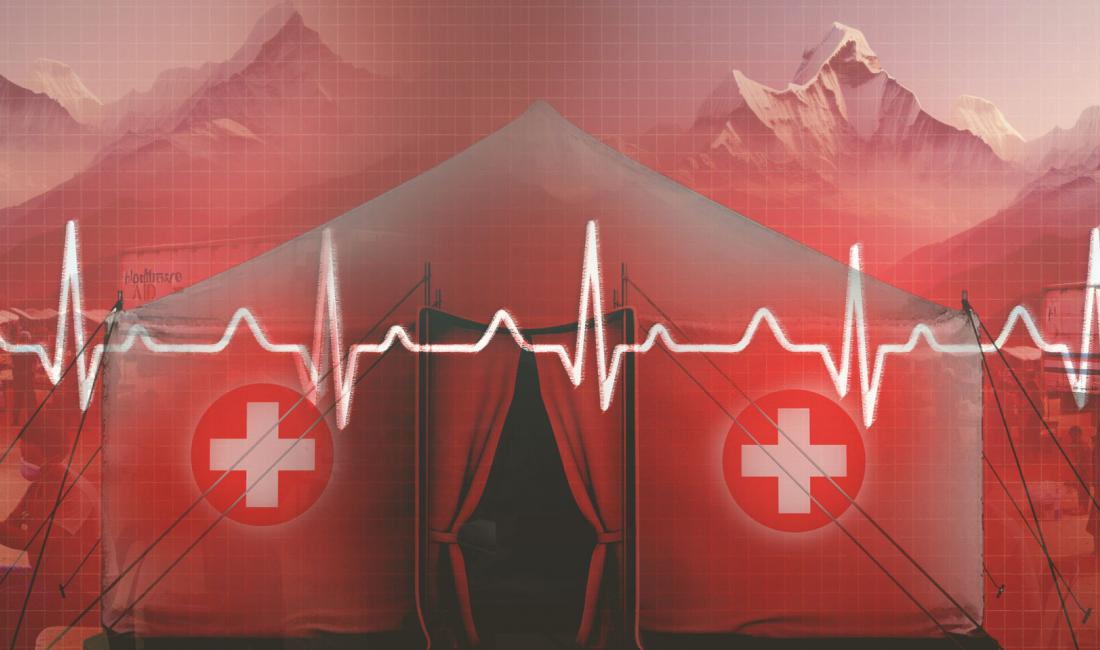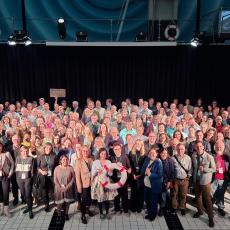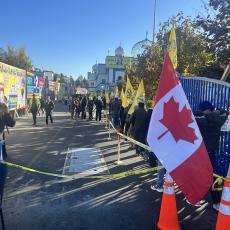Health camps deliver care in rural Nepal. But do they undermine local democracy?
This report was originally published by Asia Democracy Chronicles. Art credit: Asia Democracy Chronicles
Stting on a stool, Dr. Suman Thapa peers through a microscope as he slowly cuts across the patient’s eye with a scalpel. Incision made, he carefully probes under the cornea, making a ‘tunnel’ for the lens. He reaches forward with the scalpel and gently removes the patient’s damaged lens. Next, he rinses and inserts an artificial lens via the same opening and sets it in place. The patient’s eye is cleaned and bandaged; in 10 minutes the cataract replacement surgery is done.
The next patient is already waiting on the other side of the large room. Outside are three more, also waiting their turns on a wooden bench on a second-floor balcony overlooking a school’s dirt courtyard.
The cataract surgery is part of a health camp in a remote part of Taplejung District in northeast Nepal, bordering Tibet and India. It’s run by Ek Ek Paila (One Step at a Time), a non-government organization formed after the 2015 deadly earthquake that struck central Nepal.
This is the NGO’s 30th camp since its founding health workers, including Thapa, saw each other responding to the earthquake and realized they could have more impact working together. Since then they have traveled to remote hill and mountain areas delivering healthcare that isn’t normally available to residents.
Ek Ek Paila (EEP) isn’t unique in Nepal. While official statistics aren’t available, a conservative estimate is that dozens of organizations provide mobile health camps each year in the Himalayan country. Some of them are run by NGOs – often working with partners from overseas – others by doctors themselves, hospitals, or medical colleges.
Still others are done as ‘corporate social responsibility’ by private sector players such as banks, or by new, local diagnostic clinics to promote their services.
Some camps provide valuable one-off services, like cataract or family planning surgeries, which usually don’t require return visits. Others identify chronic health problems but pack up and leave long before the necessary follow-up.
A government official who requests anonymity recounts, “Once I was working in a remote district, which hosted an orthopedic camp with doctors from European countries. After the camp finished, some patients developed infections, but we didn’t have the correct antibiotics to treat them.”
The official echoes health experts and other observers in his worry about the potential impact of health camps on primary healthcare, which is supposed to be affordable and accessible. Such camps, says the official, are often good for simple procedures in remote areas, where access is difficult.
But he notes that even that isn’t always positive, as his anecdote about the orthopedic camp shows. Additionally, some worry that local and national governments will become less diligent in addressing the public’s healthcare needs.
Unchecked and unregulated
Anthropologist David M. Citrin, who lived in Nepal in the early 2000s, was not that sold on the benefits brought by health camps to communities either. Citrin, who did volunteer work and studied health camps while he was in Nepal, wrote in 2010: “I argue that the popularity of the short-term camp model operates in, and perpetuates, a global and national climate where ideas of ‘health’ and ‘health care’ are conflated, and where pills, surgeries, and syringes are championed at the expense of addressing the basic needs that promote and sustain health.”
One of his conclusions: “We must rethink the appropriate guidelines and boundaries for the provision of short-term medical care to people living in conditions that do not promote health … But let the necessary plans to provide prudent medical care to populations in need not supplant concerted efforts to also make it less necessary.”
In a paper written a year later, three Nepali doctors said that considering their country’s challenging geography, “health camps or outreach clinics play a vital role.” But the doctors also called for the formulation of national policies and regulations for such camps.
“The effectiveness of a health camp depends on its management, motives, funding, and planning,” the doctors wrote. “(A) health camp is conducted for the benefit of a community … but (camps) have to be checked, monitored, and recorded. A national level survey has to be done that would give a clear picture of a current scenario and would be helpful for formulating national policy.”
More than a decade later, Citrin’s observations and the doctors’ recommendations remain unaddressed. According to a 2021 paper on short-term medical missions in Nepal, health camps are still “largely unregulated, and the perceived quality and health outcomes have rarely been subject to scrutiny.”
It also said that “there is little data to support the effectiveness of one-time health camps in remote areas,” even as it pointed out that “longitudinal projects have potential to reduce the burden of (non-communicable diseases) in the communities they serve.”
Slow to catch up
Nepal’s constitution guarantees free basic healthcare to citizens, and the government is building an extensive infrastructure. For example, a recent budget promised a hospital with five to 15 beds in each of the country’s 753 local units. A 2021 survey found that 75 percent of health facilities offered basic services, a jump from 60 percent in 2015.
A new insurance program is rolling out – albeit bumpily – across Nepal’s seven provinces, to finance a basic level of care for families that cannot afford to use the mushrooming private-sector health facilities.
Despite these efforts, 58 percent of healthcare spending is paid by individuals, with the government picking up about 23 percent and external funding almost 14 percent, one report found. In rural Nepal, where the government system still dominates, facilities often lack medicine, including the drugs on the Essential Medicines List, meaning that service seekers often go home with paracetamol, if they get any drugs at all. Fresh graduates are often the only doctors available; specialists are in short supply.
According to the World Health Organization (WHO), Nepal’s doctor-patient ratio in 2021 was at 8.7 per 10,000. It also posted a health expenditure per capita of US$65.30 that year, compared to India’s US$74.04, and Sri Lanka’s US$166.18.
When Nepal restructured in 2017, creating provinces and local governments, the latter were given the main responsibility for delivering healthcare. Some have grabbed the opportunity and built or updated small hospitals or smaller health posts or health units.
But in many places the transition is still ongoing. In Karnali Province, for example, only 10 of 79 specialist doctor positions are filled and there is a total shortage of 500 healthcare workers, reported the Kathmandu Post.
In this context, health camps, which are increasingly sophisticated – the Taplejung three-day camp provided 13 services, from cataract and ear, nose and throat (ENT) surgery to ultrasound scans and blood tests — delivered by healthcare professionals, and completely free, are in demand.
Sponsored by local government
At the Tapethok health camp, Asia Democracy Chronicles asks those waiting in line to register what specific health problems they have. Voices shout, “Ankle!” “Knee!” “Heart!”
“There is a health post in our village,” says one woman in the queue. The senior staff person there is a nurse, she says, but “they only take our blood pressure and give us Cetamol.”
The woman says that they walked for about four hours to reach the health camp because “this camp is special: we can get everything checked and it’s free.”
A group of 30 people – including an 84-year-old man – traveled from a village north of Tapethok. They first walked for six hours. The next day, they rode a jeep taxi for another three hours.
Bojung Sherpa, 42, is with the group. He says he first had stomach problems six years ago, and spent NPR 500,000 (US$3,751) going to hospitals in Nepal and India for consultations. Doctors at a Kathmandu private hospital told him they could operate, for NPR180,000 (US$1,350). He didn’t have the money and returned home. He says that he’s at the camp to get medicine to supplement the ayurvedic drugs he’s been taking to keep his illness in check.
Sherpa says he doesn’t have strong opinions about local healthcare. “I don’t expect the central government or municipality to help me if I have small problems,” he says. “I can look after those. But if there’s a bigger issue, then I expect some support from them.”
Phaktanglung Rural Municipality has spent NPR 1 million (US$7,503) organizing the event, says Health Coordinator Dinesh Bhattarai. It received no help from the provincial or central government.
“This is a remote area, lacking health facilities, so we requested that the camp be organized here,” says Bhattarai. “The municipality provides minor services but (EEP) can give more specialized services, all in one place to make it easier.”
He says Phaktanglung, Nepal’s third largest municipality by area, spends about NPR 30 million (US$225,107) on health annually and is planning to expand services. It will hire a second doctor to assist the current one, who moves from facility to facility during the week; install X-ray equipment in health posts, which provide basic services like immunization, family planning, and maternal health check-ups, and are staffed by nurses and/or health assistants; and build two more, smaller, community health units, making a total of 16.
Collaboration and support
Dr. Thapa says EEP is talking with Phaktanglung officials about providing ongoing support. Under the plan, the municipality would set up and run a 15-bed hospital, including paying staff salaries. EEP would train nurses, health assistants, lab technicians and a radiographer, set up the hospital’s eye and dental departments, and provide vision, ENT, dental, and gynecology services for five years.
In terms of camps, Thapa says EEP is increasingly focused on providing eye, ENT, and dental services only, which by their nature don’t require follow-ups.
“When we fix something like cataracts or dental issues, yes it’s positive,” he says. “But when we talk about general medicine and gynaecology and all of that, I feel sometimes that it’s a waste of resources – we spend a lot of money for the whole team to go there and then they just come back.”
“For example,” he continues, “if we diagnose patients with hypertension, we give them medicines for about a month. But what happens after that? We ask them to go to the primary health centre to get a refill of the medication, which should be available there, but unfortunately many times they aren’t.
Says Thapa: “‘What follows these camps?’ is the most important question.”
Dr. Prakash Raj Regmi knows that some patients don’t go for follow-up after being diagnosed at one of his health camps, which he organizes via the Nepal Heart Foundation (NHF).
“It is a matter of great concern,” says the cardiologist, who is NHF’s National Program Director. “Some cases who are known to the local volunteers are followed up by the local unit of NHF, (but) we are unable to follow up with all these cases.”
Since 1988, NHF has been running camps to check heart health, especially for children, as well as to screen for hypertension and diabetes risk factors in adults. They have reached 300,000 children to date. But Regmi doesn’t agree that running camps like his gives governments a reason to not improve local healthcare.
“I don’t think so,” he says. “Our work is on a small scale and is only supportive to the government



